You're using an outdated browser. Please upgrade to a modern browser for the best experience.

Submitted Successfully!
Thank you for your contribution! You can also upload a video entry or images related to this topic.
For video creation, please contact our Academic Video Service.
| Version | Summary | Created by | Modification | Content Size | Created at | Operation |
|---|---|---|---|---|---|---|
| 1 | Andreas Angelakis | -- | 2682 | 2023-09-23 21:39:16 | | | |
| 2 | Rita Xu | Meta information modification | 2682 | 2023-09-25 04:42:15 | | |
Video Upload Options
We provide professional Academic Video Service to translate complex research into visually appealing presentations. Would you like to try it?
Cite
If you have any further questions, please contact Encyclopedia Editorial Office.
Angelakis, A.N.; Tzanakakis, V.A.; Capodaglio, A.G.; Dercas, N. Water Reuse. Encyclopedia. Available online: https://encyclopedia.pub/entry/49562 (accessed on 23 December 2025).
Angelakis AN, Tzanakakis VA, Capodaglio AG, Dercas N. Water Reuse. Encyclopedia. Available at: https://encyclopedia.pub/entry/49562. Accessed December 23, 2025.
Angelakis, Andreas N., Vasileios A. Tzanakakis, Andrea G. Capodaglio, Nicholas Dercas. "Water Reuse" Encyclopedia, https://encyclopedia.pub/entry/49562 (accessed December 23, 2025).
Angelakis, A.N., Tzanakakis, V.A., Capodaglio, A.G., & Dercas, N. (2023, September 23). Water Reuse. In Encyclopedia. https://encyclopedia.pub/entry/49562
Angelakis, Andreas N., et al. "Water Reuse." Encyclopedia. Web. 23 September, 2023.
Copy Citation
Wastewater treatment and reuse has passed through different development stages with time. Based on archeological evidence and time records, the awareness of the Greeks regarding land disposal, irrigation, and water reuse is highlighted. The latter has evolved into a plethora of applications, with Direct Potable Reuse (DPR) representing one of the last modern frontiers.
water reuse
history of water reuse
Greek historical data
1. Introduction
By studying the past, we learn about the present and the future.
Andreas N. Angelakis
Based on the above quote, it should be pointed out that wastewater reuse has a long history, which begins even before proper treatment was adopted. Reuse practices evolved through different development stages in time, with regards to process knowledge, treatment technologies, and the evolution of traditions, regulations, and/or guidelines. Since prehistoric civilizations, progressing to Hellenic and Roman civilizations, reuse became a common practice serving irrigation and fertilization purposes [1]. After a period of neglect, wastewater reuse practices continued to evolve after the 16th century and, despite their decline in the first half of the 20th century, reuse became again popular, mainly in areas with water scarcity problems (mainly in southeastern Greece) [2][3], but also as a means to implement recent concepts about the circularity of resources [3].
Water scarcity and droughts are likely to become more severe and more frequent due to increasing anthropic pressure and observed climate variability: already, in recent years, droughts have considerably increased in number and intensity in the EU area, affecting an estimated 11% of the population and 17% of the territory [4]. Greece and other countries in the Mediterranean region are considered to be among the world’s most water-stressed regions, as highlighted by the 2030 estimates of the water exploitation index (indicative of “water stress”) released by the European Environmental Agency (Figure 1) [5].
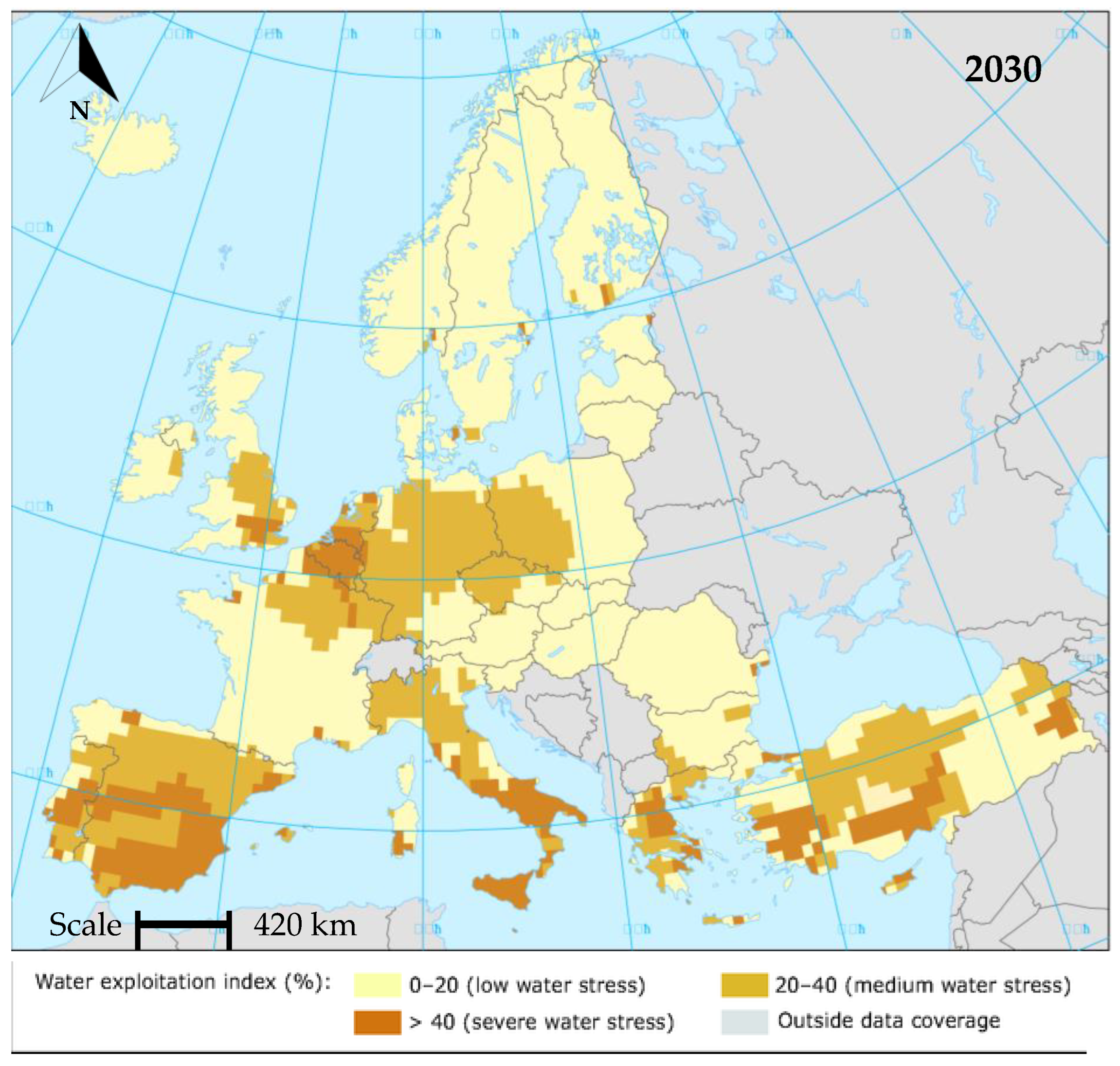
Figure 1. Water stress 2030 forecast for Europe.
Water stress is caused by over-abstraction and overuse of a finite resource; the main pressures on water resources are exerted by irrigation, which, on global average, accounts for about 70% of freshwater resources use (just over 51% as EU average), with about 24% consumed by urban demand followed by the power and industrial sectors. Reduced availability of water resources is also caused by pollution of surface and groundwaters. A peculiar problem in the Mediterranean region is given by tourism, which could cause significant stress in areas with already limited water resources (e.g., popular destination islands in Greece, Italy, Spain, and elsewhere).
Wastewater is the only remaining potential water source bound to increase as the population grows and consumes greater amounts of water. Treated wastewater could hence be considered a reliable supply source, largely independent from seasonal droughts and weather variability. Wastewater was viewed throughout millennia as a resource that must be recovered and considered part of the available water budget. The United Nations (UN) [6] has defined wastewater as a yet untapped available water source; the global transition to Circular Economy [7] could be supported by improving wastewater treatment and increasing reuse, as called for in Sustainable Development Goals Target 6.3 (Clean Water Sanitation).
Due to climate variability and increasing drought phenomena in the climate-vulnerable areas of the planet (e.g., the Mediterranean basin), the use of reclaimed wastewater poses a valuable option, at least for crop irrigation to support crop production and the agricultural economy. Indeed, in the Mediterranean region reuse of treated wastewater is increasing: in Jordan and in Israel, about 90% and 85% of wastewater is currently reused for agricultural irrigation, respectively [8]. It is estimated that treated wastewater could already replace about 12% of freshwater used for agricultural irrigation globally [7]. If treated wastewater was recognized as part of the hydrological cycle and managed within the integrated water resources management (IWRM) process, this would contribute to meeting the water requirements and accepting the “one water” concept.
In modern times water quality monitoring has much evolved from the past [9]; new contaminants have been identified, and water quality standards for pollutants are well-defined and more stringent. As a consequence, the technologies for wastewater treatment must necessarily keep up with all possible reuse expectations. This is mainly applied to the developed countries that can undertake this process. Unfortunately, developing countries cannot have this ability, and this is why the Food and Agricultural Organization of UN (FAO) and the World Health Organization (WHO) have less stringent water quality standards that do not focus solely on wastewater quality but on other measures such as immunization, types of irrigation, etc.
Historically, in Greece and other countries with low water availability, wastewater derived from wastewater collection systems has been the principal source of reclaimed water. However, population growth and urbanization, combined with limited reliable water resources, have also contributed to the consideration of a wider range of potential water sources for reclamation and reuse. Since the beginning of this century in Greece, small and decentralized wastewater systems have increased and in the future, the potential for wastewater management systems and reclamation and reuse should be improved.
2. Water Reuse from Prehistoric to Medieval Era (ca 3200 BC–1400 AD)
2.1. Prehistoric Times (ca 3200–1100 BC)
The first evidence of the use of wastewater for agricultural irrigation and fertilization dates back to ca 5000 years ago, during the Bronze Age of Minoan and Indus Valley civilizations [10]. Advanced drainage and sewerage systems were developed by Minoans for disposing of wastewater to rivers (e.g., in Knossos palaces) or to the sea (e.g., Zakros palace) and/or to agricultural land (e.g., Phaistos palace and Villa of Hagia Triada). In the Palace of Phaistos, the outlet of the wastewater/stormwater drainage system (Figure 2a) was used to divert this stream to the nearby farmland (Figure 2b). A section of the sewage and stormwater drainage system of the Villa of Hagia Triada is shown in Figure 2c; one of the cisterns used to collect and store this flow onsite for agricultural uses (Figure 2d).
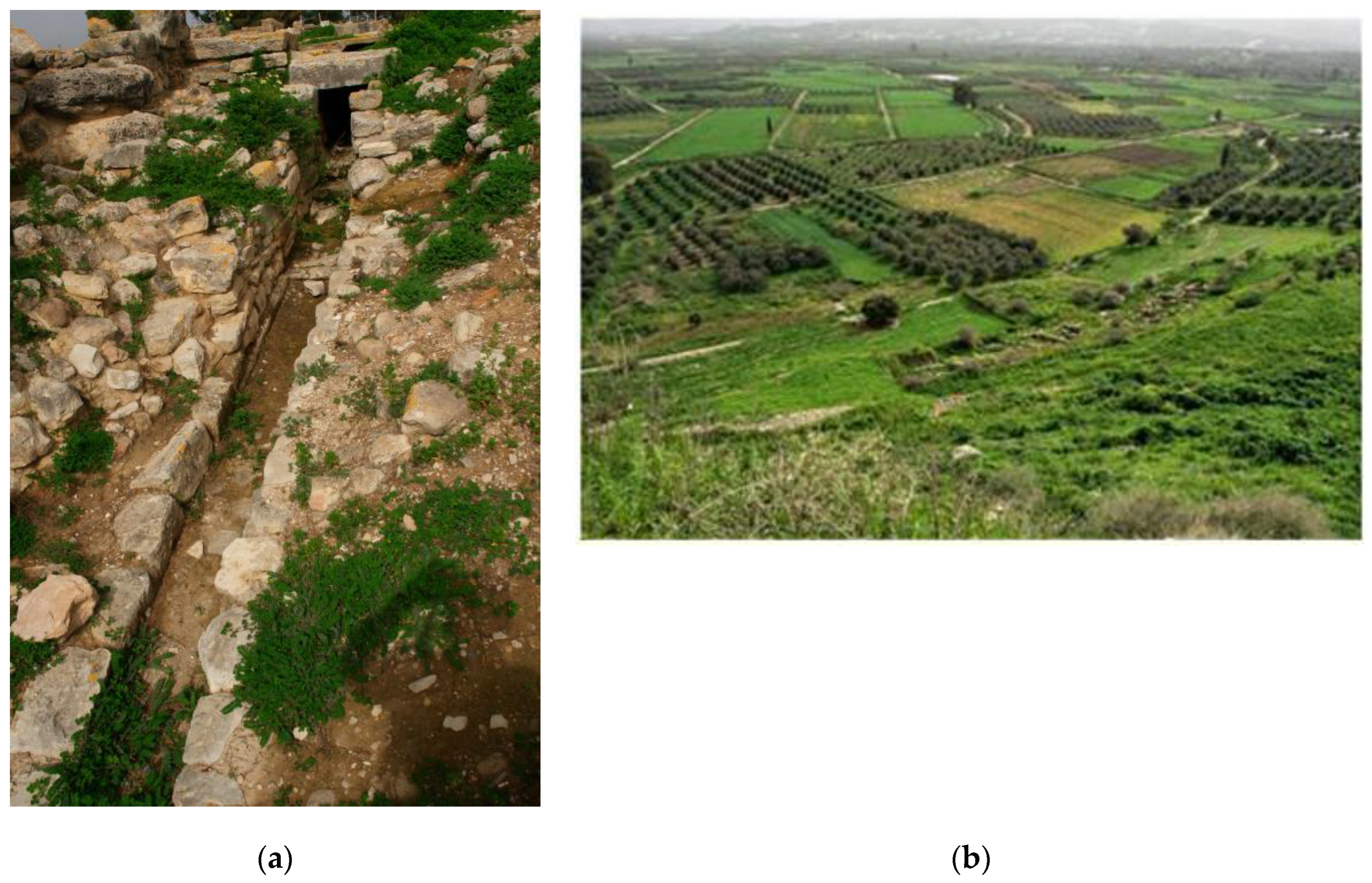
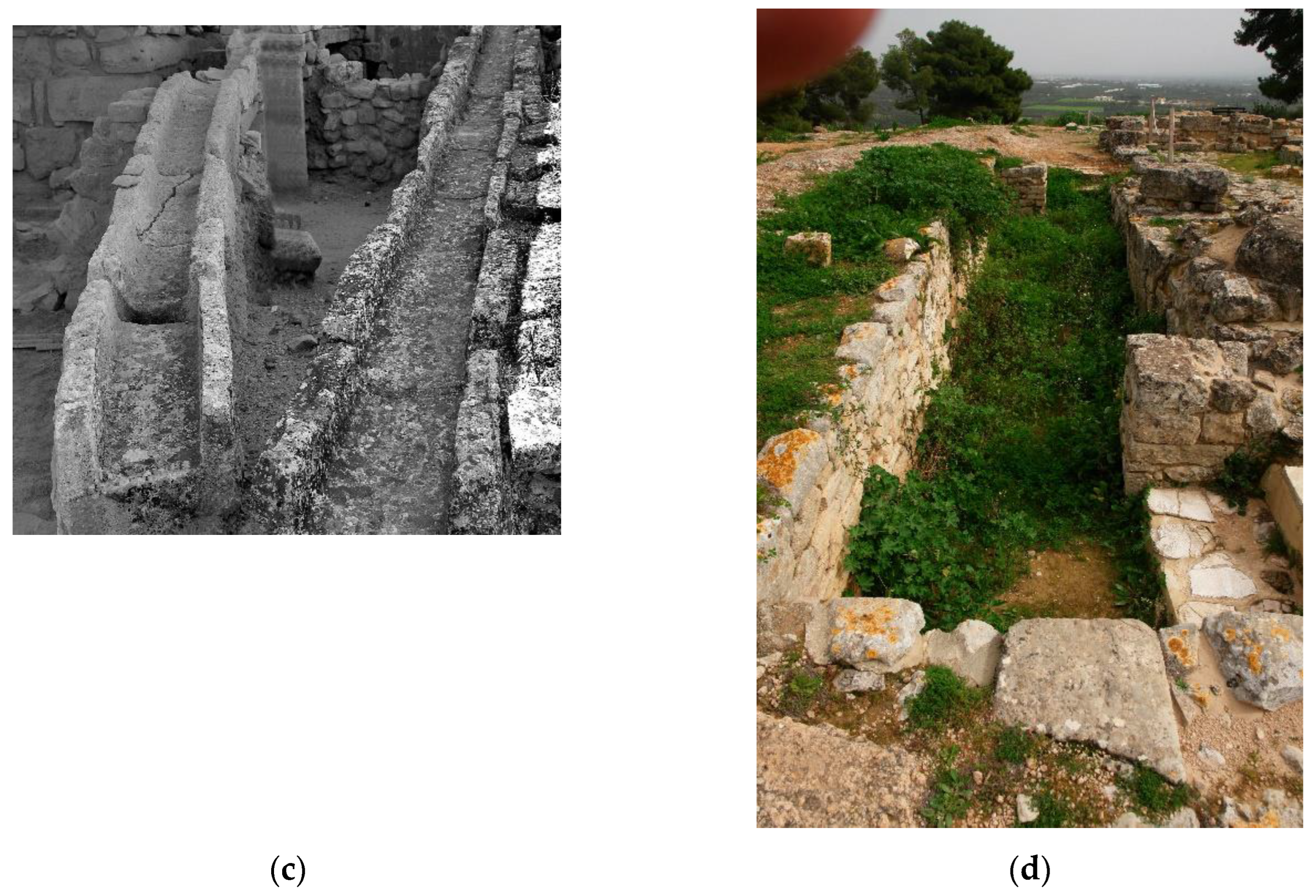
Figure 2. Water reuse in prehistoric times: (a) drainage channels in the palace of Phaistos and (b) downhill farmland irrigated by the flow; (c) drainage channels in Hagia Triada and (d) cistern in Hagia Triada for storage of water targeted for land application (Photos are of Andreas N. Angelakis).
The villa of Hagia Triada and Phaistos probably had the most advanced ancient Minoan drainage system. This system was admired by several visitors, including the Italian writer Angelo Mosso [11], who visited the area in the early 20th century. During heavy rain, he noticed the still-perfect functionality of the system, and commented: “I doubt if there is another case of a stormwater drainage system that works 4000 years after its construction.” The American writer Harold Gray [12] similarly said: “Perhaps we also may be permitted to doubt whether or not our modern sewerage systems will still be functioning after even one thousand years.” Minoans planned and constructed installations that functioned for centuries, unlike today, when a project is considered satisfactory if it operates well for 40–50 years [13].
2.2. Historical Times (ca 1100 BC–476 AD)
In practice, all water on the planet is continuously reused and recycled and reused in an endless cycle. The Ionian philosopher Anaximandros (ca 610–547 BC) was the first to refer to meteorological phenomena, hydrological processes, and, broadly speaking, to water recycling: “Rains are generated from the evaporation (atmis) that is sent up from the earth toward under the sun” (Hippolytus, Ref. I 6, 1-7-D. 559 W.10). Thereafter, Aristotle (384–322 BC) referred to the water phase change: “The sun causes the moisture to rise…….Even if the same amount of water does not come back every year and in a given place, yet in a certain period all quantity that has been abstracted is returned” (ibid, II.2, 355a 26) [14]. He also reported that “Salt water when it turns into vapour becomes drinkable [freshwater] and the vapour does not form salt water when it condenses again; this I know by experiment”. (Meteorologica, II 3). However, the balance of the natural hydrological cycle has been disturbed due to the explosion of the global population, which, in turn, has led to an ever-increasing demand for water. Thus, nowadays, water resources are exploited at a rate that exceeds their natural regeneration rate.
Ancient Greeks continued the Minoan tradition of wastewater reuse in agriculture at a larger scale [10][15]. During the Classical and Hellenistic periods, wastewater and stormwater were removed by city-wide drainage and sewerage systems dug in lateral streets between houses. An ancient drainage and sewerage system was discovered southeast of Athen’s Acropolis, which consisted of a stone central sewer and drain which collected wastewater and rainfall from surrounding houses.
Sewers with larger cross-sections were built of stone in a variety of different ways. In the most sophisticated case, storm water drains are carved of stone exposed like a canal. Two examples are given in Figure 3a, which depicts a drain in the Agora of ancient Messene in southwestern Peloponnesus, a city built in 379 BC, which was known for its walls, the best preserved in Greece and the strongest in antiquity [15]. Moreover, the great drain and sewer under the Agora in ancient Athens delivered a mix of runoff and wastewater into a large collection basin (Figure 3b) [16], from which they were directed to the agricultural fields located in the downhill areas—which, nowadays, are known as Elaionas—through brick-lined conduits [17]. Similar systems were found elsewhere; for example, in the hill of Pnyx, where a series of drains were unearthed during archaeological excavations [18]. Throughout the ages, human civilizations have paid close attention to wastewater and have reused it in various ways. In arid climates in particular, wastewater would pass through many reuse cycles, a fact attested to by both Classical Greek, Jewish, and Roman literature. Furthermore, unplanned, incidental or de facto reuse of wastewater had a very long history throughout the medieval periods [19].
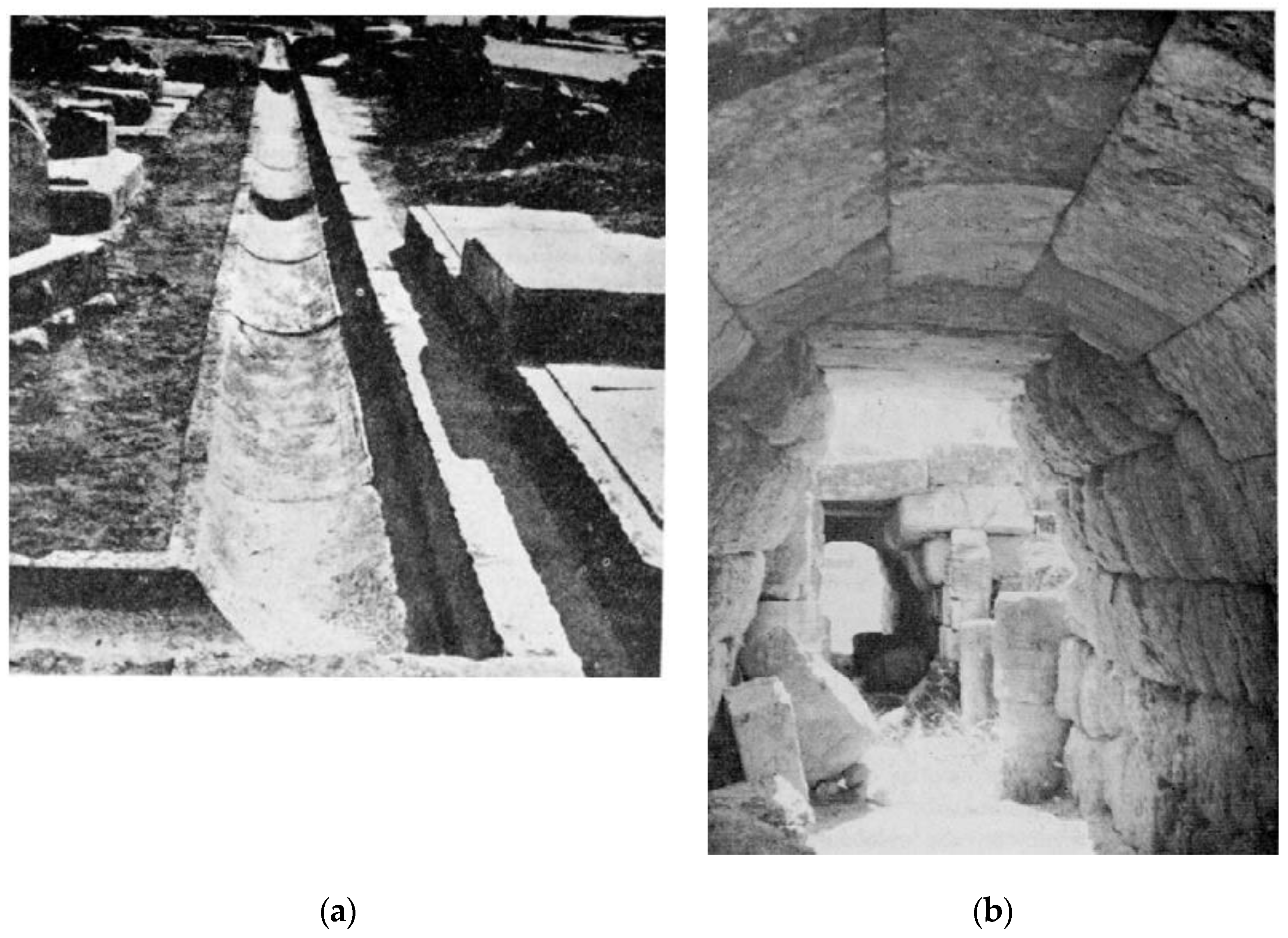
Figure 3. Sewers and drains in ancient Greece: (a) drain in the Agora of ancient Messene; (b) drain and sewer in the Agora of ancient Athens (with permission of Prof. Nikos Mamassis).
2.3. Medieval Times (ca 476–1400 AD)
Romans were excellent hydraulic engineers, as testified by the ancient infrastructure that can still be seen nowadays, sometimes in operational efficiency. Alongside the construction of elaborate aqueducts carrying water for several kilometres, cisterns for harvesting storm rooftop runoff for domestic uses were discovered in Pompeii’s archaeological site. In the post-Roman period (ca 476–1400 AD), however, there was no improvement in the methods of waste removal, and little progress was made in water technology and knowledge. Although water reuse persisted in a few places, as testified by the remains of fishponds from the 13th century receiving nutrient-rich wastewater from abbey latrines discovered in Germany and France, sanitation in urban centers mostly reverted, at best, to basic practices. Lack of sanitary precautions resulted in outbreaks of infective disease [20]. As urban populations expanded, the disposal of human excreta, largely unregulated, became a critical issue in large cities. For example, in Paris, property owners were required to provide new dwellings with onsite cesspools only in 1530 [21]. Residents were willing to pay only for their neighborhood sewers, often discharging into the next one [21]. This vision, a sort of NIMBY approach for the times, was exported to Australia and the Americas, which were discovered and populated by European immigrants.
3. Early and Mid-Modern Times (ca 1400–1900 AD)
During this period, concerns regarding water and health issues were gradually developed. During the Renaissance (ca 15th–17th centuries), sedimentation tanks and soil filtration systems were introduced. In mid-1800 “sewage farming”, a modern, slightly cleaner version of the ancient Greek wastewater disposal system became relatively common in England and other European countries, and into the 1890s, land treatment systems (LTS) use was extended to Mexico and Australia. Thereafter (from the beginning of the 20th century), LTS were adopted in the USA and Europe, including Greece. In 1914, sanitary engineers, E. Arden and W. T. Lockett from the River Committee of the Manchester Corporation, discovered the principles of the activated sludge process [22]. This opened the way for the separate reuse of low-organic-load treated effluents and biosolids.
4. Current Status of Water Reuse in Greece
More than 492 WWTPs in Greece produce effluents with high reuse potential countrywide; at present, however, treated effluents are in most cases still discharged into the sea. Agricultural irrigation is the main consumer of water in Crete, with about 7828 million m3/yr (~85% of total demand), as a consequence of local hydrological and microclimatic conditions. Treated effluents can be reused to irrigate crops or replenish aquifers and even hinder seawater intrusion [23]—an important option, particularly in more vulnerable areas of Greece such as the southern part and the islands, which suffer periodically from intense water scarcity phenomena [24]; they can also be seen as a potential source of nutrients for crops, reducing the use of industrial fertilizers and thereby their environmental and economic impact [3].
While water reuse is a high national priority issue, several factors are responsible for the limited use of recycled water in Greece so far. An important factor lies in current national and EU legislations setting strict quality limitations [25][26]. For example, the monitoring of metalloids and heavy metals, with frequency from 2 (<10,000 p.e.) to 12 (>200,000 p.e.) times per year, as well as the monitoring of several organic compounds at least twice/year (˃100,000 p.e.), are required. Moreover, EU guidelines set minimum quality requirements for aquifer recharge and crop irrigation [27], and there is the possibility of additional limits for several substances (such as pharmaceuticals, disinfection by-products, anti-microbial resistance genes, pesticides, and others) [28]. Another reason for limited water reuse is low acceptance by farmers and consumers [25][29]; this is mainly related to health risks perception and, in part, to the present pricing policy of fresh and reused sources, which often implies additional user costs for the latter. Potential solutions to overcome these obstacles could be the revision of water quality criteria and/or improved monitoring solutions, new pricing policies for non-conventional water sources, and the application of advanced certification processes [23] compatible with current products and EU policy frameworks [30].
The Case of Attica
The Attica region, with an area of 3808 km2, is the most urbanized area in Greece; around 3.9 million people, almost 40% of the total national population, live there, and they are mostly concentrated in the city of Athens. In the Greater Athens area, there are three biological nutrient removal (BNR) WWTPs: the largest, Psyttalia WWTP with 3,500,000 p.e. design capacity; the Metamorphosi WWTP in the northwest (500,000 p.e.); and the Thriasio WWTP, with a design capacity of 117,000 p.e., in the west. Another three WWTPs are constructed or planned for construction along the East Attica coastline (Figure 4).
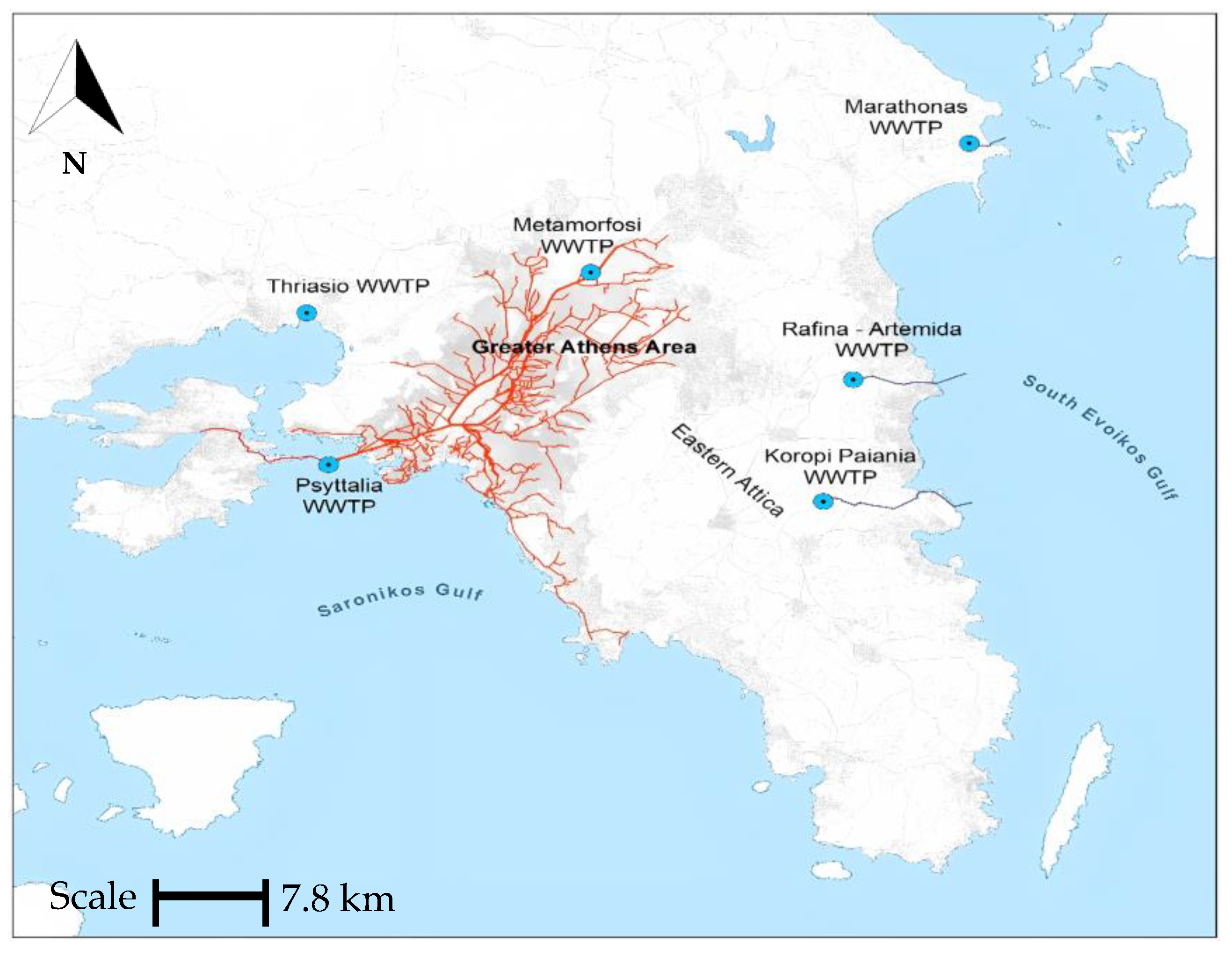
Figure 4. Existing WWTPs and planned with the sewerage network of Attica.
The Psyttalia island WWTP, started in 1995, with a hydraulic capacity of 300 million m3/yr, is the largest one in the country, and it includes nutrient removal (advanced secondary treatment) and sludge treatment with the generation of heat and electricity from produced biogas. Three other major wastewater projects are under construction in East Attica for the cities of Rafina/Artemida, Marathonas, and Koropi/Paiania. That of Rafina/Artemida is under construction, Koropi/Paiania has been constructed but the sewerage networks are still under construction, and the Marathonas project is planned. However, these WWTPs are planned to produce reclaimed water suitable for aquifer recharge, restoring the quantity of groundwater bodies. The implementation of the above will be the largest water reuse project in Greece after the one in the city of Thessaloniki in the northern area of the country.
In the future, seasonal increases in the served population due to the expected development of summer tourism could further reduce water availability, especially if combined with the possible onset of drought episodes. It is known that drought periods have always occurred in Greece; for example, in ancient Athens, droughts occurred in the eighth, fourth, second (etc.) century BC and on many other occasions [31]. Thus, potable reuse plays an important role in the development of sustainable water supply augmentation strategies, especially in high-density urban areas such as Attica. The case of Attica shows that water withdrawal from inland areas (up to 220 km away), transportation to cities, treatments, and disposal to coastal waters after a single use is unsustainable [10]. Retrospectively, if the Psyttalia WWTP had been built on the mainland with the incorporation of advanced effluent treatment and reuse, Athens could have become a more water-resilient city today.
References
- Tzanakakis, V.E.; Koo-Oshima, S.; Haddad, M.; Apostolidis, N.; Angelakis, A.N. The History of Land Application and Hydroponic Systems for Wastewater Treatment and Reuse. In Evolution of Sanitation and Wastewater Management through the Centuries; Angelakis, A., Rose, J., Eds.; IWA Publishing: London, UK, 2014; Chapter 24; pp. 459–482.
- Tsagarakis, K.P.; Tsoumanis, P.; Chartzoulakis, K.; Angelakis, A.N. Water resources status including wastewater treatment and reuse in Greece: Related problems and prospectives. Water Int. 2001, 26, 252–258.
- Mainardis, M.; Cecconet, D.; Moretti, A.; Callegari, A.; Goi, D.; Freguia, S.; Capodaglio, A.G. Wastewater fertigation in agriculture: Issues and opportunities for improved water management and circular economy. Environ. Pollut. 2021, 296, 118755.
- EC. Water Reuse. 2022. Available online: https://ec.europa.eu/environment/water/reuse.htm#:~:text=At%20present%2C%20about%201%20billion,of%20annual%20EU%20freshwater%20withdrawals (accessed on 15 March 2023).
- EEA. European Environmental Agency. Data and Maps. 2019. Available online: https://www.eea.europa.eu/data-and-maps/figures/water-stress-in-europe/figure_4_3_3_left_graphic.eps (accessed on 15 March 2023).
- UN-WATER. Annual Report 2017; UN-Water Technical Advisory Unit: Geneva, Switzerland, 2018.
- UN-WATER. United Nations–Water. Wastewater: The Untapped Resource; United Nations Educational, Scientific and Cultural Organization: Paris, France, 2017.
- Capodaglio, A.G. Fit-for-purpose urban wastewater reuse: Analysis of issues and available technologies for sustainable multiple barrier approaches. Crit. Rev. Environ. Sci. Technol. 2021, 51, 1619–1666.
- Capodaglio, A.G.; Callegari, A.; Molognoni, D. Online monitoring of priority and dangerous pollutants in natural and urban waters: A state-of-the-art review. Manag. Environ. Qual. Int. J. 2016, 27, 507–536.
- Angelakis, A.N.; Asano, T.; Bahri, A.; Jimenez, B.E.; Tchobanoglous, G. Water reuse: From ancient to modern times and the future. Front. Environ. Sci. 2018, 6, 26.
- Mosso, A. Escursioni nel Mediterraneo e gli Scavi di Creta; Treves: Milano, Italy, 1907.
- Gray, H.F. Sewerage in Ancient and Medieval Times. Sew. Work. J. 1940, 12, 939–946. Available online: http://sewerhistory.orgwww.sewerhistory.org/articles/whregion/1940_as201/article1.pdf (accessed on 20 January 2019).
- Koutsoyiannis, D.; Zarkadoulas, N.; Angelakis, A.N.; Tchobanoglous, G. Urban water management in Ancient Greece: Legacies and lessons. J. Water Resour. Plan. Manag. 2008, 134, 45–54.
- Koutsoyiannis, D.; Angelakis, A. Hydrologic and Hydraulic Sciences and Technologies in Ancient Greek Times. In Encyclopedia of Water Science; CRC Press: Boca Raton, FL, USA, 2003; pp. 415–418.
- Angelakis, A.; Koutsoyiannis, D.; Tchobanoglous, G. Urban wastewater and stormwater technologies in ancient Greece. Water Res. 2005, 39, 210–220.
- Antoniou, G.P.; Angelakis, A.N.; Mitchell, P. Latrines and wastewater sanitation technologies in ancient Greece. In Sanitation, Latrines and Intestinal Parasites in Past Populations; Ashgate Publishing: Surrey, UK, 2015; pp. 41–68.
- Yannopoulos, S.; Lyberatos, G.; Theodossiou, N.; Li, W.; Valipour, M.; Tamburrino, A.; Angelakis, A. Evolution of water lifting devices (pumps) through the centuries worldwide. Water 2015, 7, 5031–5060.
- Kalavrouziotis, I.K.; Koukoulakis, P.H.; Drakatos, P.A. Water and wastewater management in antiquity in the context of an ethically oriented environmental protection. Int. J. Glob. Environ. Issues 2015, 14, 226–237.
- Angelakis, A.N.; Rose, J.B. Evolution of Sanitation and Wastewater Technologies through the Centuries; IWA Publishing: London, UK, 2014.
- Schladweiler, J.C. Tracking down the Roots of Our Sanitary Sewers. 2002. Available online: https://ascelibrary.org/doi/10.1061/40641%282002%2958 (accessed on 15 March 2023).
- Burian, S.J.; Edwards, F.G. Historical Perspectives of Urban Drainage. In Proceedings of the 9th International Conference on Urban Drainage, ASCE, Portland, OR, USA, 12 July 2022.
- Arden, E.; Lockett, W.T. They Discovered the Activated Sludge Process. Historia Sanitaria. 1914. Available online: https://www.wiki.sanitarc.si/1914-w-t-lockett-discovered-activated-sludge-process/ (accessed on 15 March 2023).
- Tzanakakis, V.; Angelakis, A.; Paranychianakis, N.; Dialynas, Y.; Tchobanoglous, G. Challenges and Opportunities for Sustainable Management of Water Resources in the Island of Crete, Greece. Water 2020, 12, 1538.
- Tzanakakis, V.A.; Paranychianakis, N.V.; Angelakis, A.N. Water Supply and Water Scarcity. Water 2020, 12, 2347.
- Paranychianakis, N.; Salgot, M.; Snyder, S.; Angelakis, A. Quality criteria for recycled wastewater effluent in EU-countries: Need for a uniform approach. Crit. Rev. Environ. Sci. Technol. 2015, 45, 1409–1468.
- CMD. Common Ministerial Decision. In Measures, Limits and Procedures for Reuse of Treated Wastewater; No. 145116; Ministry of Environment, Energy and Climate Change: Athens, Greece, 2011. (In Greek)
- EU. EU Regulation 2020/741 of the European Parliament and of the council of 25 May 2020 on minimum requirements for water reuse. Off. J. Eur. Union 2020, L 177/32.
- EC-COM. European Commission. Communication from the Commission to the European Parliament, the Council and the European Economic and Social Committee, European Union Strategic Approach to Pharmaceuticals in the Environment; (COM(2019) 128 final); European Commission: Brussels, Belgium, 2019.
- Menegaki, A.N.; Hanley, N.; Tsagarakis, K.P. The social acceptability and valuation of recycled water in Crete: A study of consumers’ and farmers’ attitudes. Ecol. Econ. 2007, 62, 7–18.
- EU. EU-Level Instruments on Water Reuse: Final Report to Support the Commission’s Impact Assessment; EU: Brussels, Belgium, 2016; Available online: https://ec.europa.eu/environment/water/blueprint/pdf/EU_level_instruments_on_water-2nd-IA_support-study_AMEC.pdf (accessed on 15 March 2023).
- Baloutsos, G.; Rousos, A. Identification and Verification of Extreme Droughts in Greece from the 14th to the 19th Century—Their Contribution to the Adaptation of Corresponding Potential Phenomena during the 21st century (In Greek). Dasarxeio. Com. 2020. Available online: https://dasarxeio.com/2020/06/26/82686/ (accessed on 15 March 2023).
More
Information
Subjects:
Water Resources
Contributors
MDPI registered users' name will be linked to their SciProfiles pages. To register with us, please refer to https://encyclopedia.pub/register
:
View Times:
831
Revisions:
2 times
(View History)
Update Date:
25 Sep 2023
Notice
You are not a member of the advisory board for this topic. If you want to update advisory board member profile, please contact office@encyclopedia.pub.
OK
Confirm
Only members of the Encyclopedia advisory board for this topic are allowed to note entries. Would you like to become an advisory board member of the Encyclopedia?
Yes
No
${ textCharacter }/${ maxCharacter }
Submit
Cancel
Back
Comments
${ item }
|
More
No more~
There is no comment~
${ textCharacter }/${ maxCharacter }
Submit
Cancel
${ selectedItem.replyTextCharacter }/${ selectedItem.replyMaxCharacter }
Submit
Cancel
Confirm
Are you sure to Delete?
Yes
No




